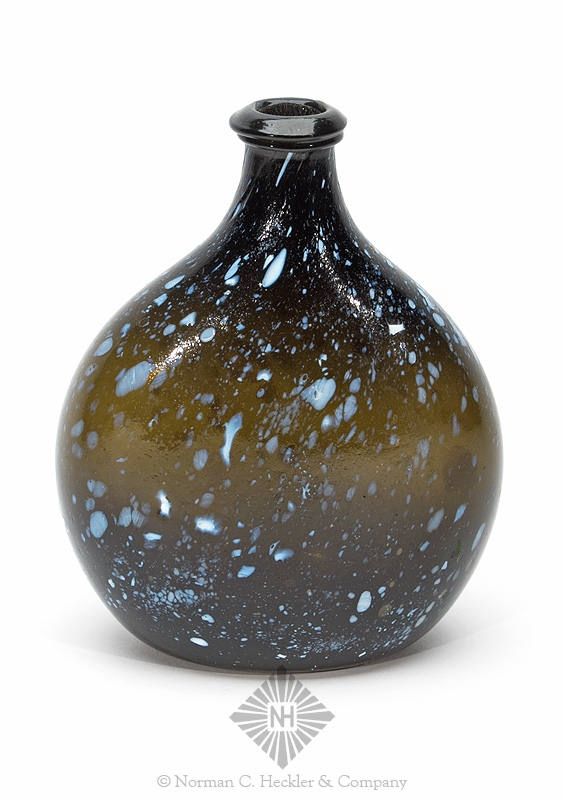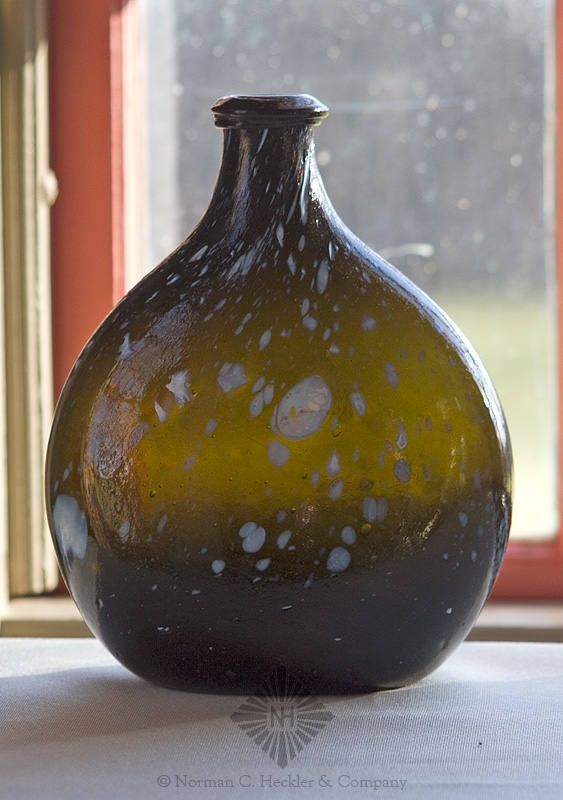Chestnut Flask: Origin?
Hi, Chris:
As you may recall, I acquired quite a few chestnut flasks from you many years ago. I am still collecting them and have developed a very large collection of nice pieces. But I am a bit stumped by this one and am hoping that you and/or your forum participants can help me confirm the origin of this particular flask (see photos), recently acquired from one of the auction houses. The description from the auction is: "Possibly Saratoga Mountain Glass Works, Saratoga, New York, 1844-1860. Deep olive amber with milkglass flecks, applied sloping collared mouth with ring - pontil scar, ht. 6 1/2 inches. Similar in form and construction to McK plate 69, top row, #7 Early form. Fine condition. Charles and Joy Flint collection." As you can see from one of the photos, a hand-written note on the bottom of the bottle indicates a "Mt. Plesant [sic] Glass Works" origin.
I have never seen this type of lip on a chestnut. And the glass is very heavy and more opaque than on any chestnut I've encountered.
Any thoughts on its origin?
Thanks!
Dave Eden
Crownsville, MD



As you may recall, I acquired quite a few chestnut flasks from you many years ago. I am still collecting them and have developed a very large collection of nice pieces. But I am a bit stumped by this one and am hoping that you and/or your forum participants can help me confirm the origin of this particular flask (see photos), recently acquired from one of the auction houses. The description from the auction is: "Possibly Saratoga Mountain Glass Works, Saratoga, New York, 1844-1860. Deep olive amber with milkglass flecks, applied sloping collared mouth with ring - pontil scar, ht. 6 1/2 inches. Similar in form and construction to McK plate 69, top row, #7 Early form. Fine condition. Charles and Joy Flint collection." As you can see from one of the photos, a hand-written note on the bottom of the bottle indicates a "Mt. Plesant [sic] Glass Works" origin.
I have never seen this type of lip on a chestnut. And the glass is very heavy and more opaque than on any chestnut I've encountered.
Any thoughts on its origin?
Thanks!
Dave Eden
Crownsville, MD



Comments
Looks like Nailsea glass from England. Nice!
I remember well, long time, no see. Were you at the Baltimore show this year?
My gut reaction is English based on the similarity of that lip to black glass cylinders I have seen over the years...as well as the general presentation of the base. But we all know European traditions crossed the Atlantic and were continued here. I have several bottles in my collection which, if I showed you just the lip you would say one thing but the entire bottle says American
Chris
Do you know of any American glasshouse that is known to have produced the glass chip speckling that is well known from Nailsea? I don't.
As to whether such pieces were Saratoga Mtn or Congressville, I do not know.
Would you happen to have access to McK plate 69, top row, #7, which is referenced within the auction posting text (cited above by me)? I do not have access to the McKearin texts and am hoping that you might. Thanks!
Dave Eden
The McKearins say on page 188 that Congressville was the only glasshouse where they definitively knew Nailsea glass was produced. I am not sure if subsequent research has changed this view..